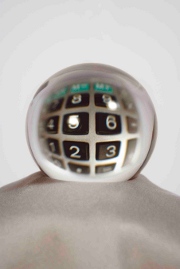A magazine where the digital world meets the real world.
On the web
- Home
- Browse by date
- Browse by topic
- Enter the maze
- Follow our blog
- Follow us on Twitter
- Resources for teachers
- Subscribe
In print
What is cs4fn?
- About us
- Contact us
- Partners
- Privacy and cookies
- Copyright and contributions
- Links to other fun sites
- Complete our questionnaire, give us feedback
Search:
The fast five calculation

Five fingers, five toes. Fives are all around us. Impress you friends with your ability to divide any number by 5 at super speed, and do the calculation correct to three decimal places!
Divide and Conquer
Not a lot of people know this, but dividing a large number by five can actually be done by a very simple two-step method. Step 1 multiply the number by 2 and step 2 move the decimal point. That's all there is to it.
Let's start it easy
It is always a good idea to start easy with a simple example to test our method works, so let's look at 10/5. First our method says we double the number: doubling 10 gives 20. Then we shift the decimal point, so 20 now becomes 2.0 or 2, and the answer's correct. Good start.
Now for a harder example: 190 / 5. This looks tough without a calculator, but step 1 double 190 to get 380, and step 2 move the decimal point, so 380 becomes 38.0 or just plain old 38.
Harder still: 4567 / 5. Again step 1, double the number up: 4567 x 2 = 9134, then step 2, shift the decimal point to get 913.4 (It's correct, check with a calculator if you don't believe me)
Now let's get silly: 123456789 / 5. Step 1 double it up 2 x 123456789 = 246913578, and step 2 shift the decimal point and the answer is 24691357.8 (You may really want to check this on a calculator, but it is correct.)
Can maths save you future embarrassment? Could there be a number somewhere that you haven't tested that the trick doesn't work for? That would be embarrassing so let's look at the maths. That way we can be sure: we can prove it will always work and save red faces all round.
Dividing by five is like doing half of a divide by 10, divide by 10 is easy, you just shift the numbers down a 'slot', so 100/10 = 10.0, 23 /10 = 2.3 and so on. What does this let us do then?
A properly useful property of division
Division has a rather neat trick of its own (it's called a mathematical property). If you do the same to the top of a fraction as you do the bottom, the ratio (the division) remains the same, so 4/2 = 8/4 = 16/8 = 2, here we have multiplied the top and bottom by two each time, but the result is the same.
Suppose we take any number A and divide it by 5 as in our problem. We want A/5 but by the above property that is exactly the same as (2xA)/(2x5) or (2xA)/10. We have just multiplied top and bottom of A/5 by two. There we have it. That simple formula proves the maths. It says that to divide ANY number A by 5 we can do it by first doubling A (step 1) and then shifting the decimal place, that is divide by 10, (step 2). No need to worry it will always work.
What we have done here is what mathematicians and computer scientists do all the time (no not divide by 5!). We have come up with a series of steps (which we call an algorithm) and then shown mathematically that the steps will always do what they are supposed to.
You said correct to three decimal places?
Of course our claim to do the calculation correct to 'three decimal places' is just presentation to make it sound more impressive. It's really easy. All you do is take the answer, say 23.7, and add two zeros after the 7 to give 23.700. That's the answer right to three decimal places as you promised. In fact our maths proof shows us that we will only ever get an answer with one decimal place as we just divide by 10. The rest is just magical flim flam.
Going the other way (a challenge)
Here is a two step algorithm to multiply a number by 5. Step 1 divide by 2, and step 2 move the decimal point to the right. Try a bit of proof yourself: can you work out if this will method will always work?


